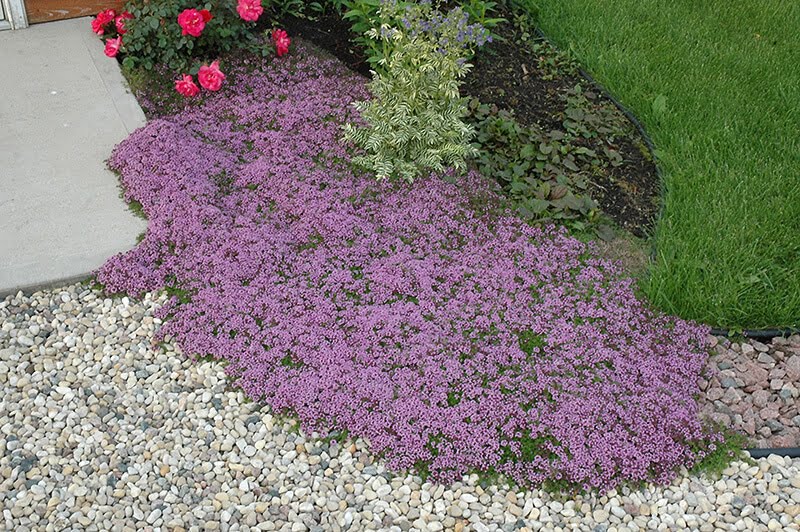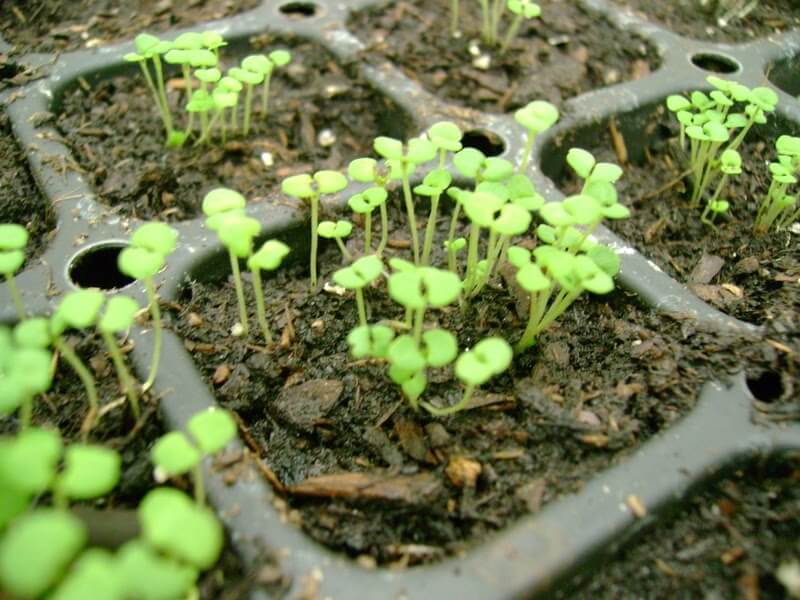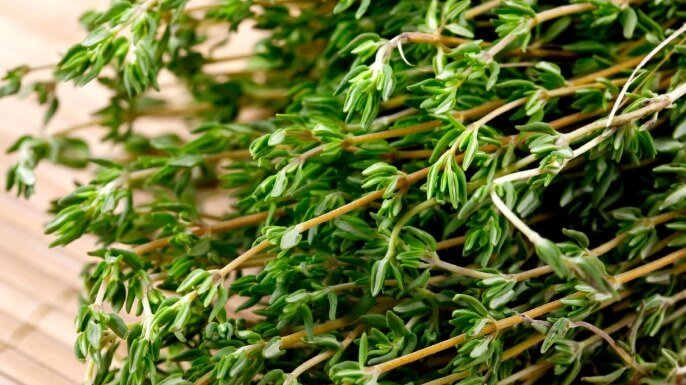If you’re looking for things to plant in your garden that can serve more than one purpose, that is to be both a beautiful addition to your plant collection and something that you can use as an ingredient in your meals, you should definitely consider planting some creeping thyme. Creeping thyme is a low-growing herb that can be used as a ground cover, as well as a delicious addition to your food. Moreover, it’s low-maintenance, so it is suitable for people who don’t want to spend a lot of time tending to the garden. Today, we’re going to take you through all the steps of growing creeping thyme.
How to Grow Creeping Thyme in 8 Easy Steps
Step 1: Purchase Thyme Seedlings
While growing creeping thyme from seedlings isn’t the only option you have, it is the best one. You can also grow it from seeds or plant divisions, but you’ll find that with seeds, the germination might be uneven and sluggish. We recommend you to buy some seedlings instead.
Step 2: Choose an Appropriate Spot
The place where you’re going to plant your creeping thyme is important when ensuring that your plants will get the maximum amount of benefits and protection. The first thing that you should know is that creeping thyme enjoys well-drained soil. In terms of the hardiness zone that they require, the most appropriate ones are those between 5 and 9. Since thyme is of Mediterranean origin, it grows best in places where the winters are warm and the summers are cool. If you live in a warm climate, we suggest planting creeping thyme in partial shade, but if you live in a Mediterranean climate, planting it in full sun would be best.
The soil’s pH level is another factor that you should take into account. You can purchase a soil test kit and follow the instructions in order to find out if your soil is ready for you to plant creeping thyme, or if you have to do something to improve its quality. The perfect soil should have either an alkaline or a neutral pH level. More precisely, your soil should have a pH level in between 6.0 and 8.0. If the pH is lower than that, you can add some lime to the soil.
Since creeping thyme does wonderfully as a ground cover, you can also choose to plant it between bricks and stepping stones, or even between other vegetables, such as cabbage. This will also help keep away cabbage worms, which are repelled by the smell of thyme. Strawberries can also benefit from you planting creeping thyme next to them, as a border. This will attract more bees and deter harmful insects.
Step 3: Plant the Creeping Thyme Seedlings
The best time to plant creeping thyme is in early spring, after the last frost. The ground should now be warm, more precisely it should have about 70 degrees Fahrenheit. You have to plant the seedlings about 8 to 12 inches apart, in soil that drains well. If you’re not satisfied with how the soil in your garden drains, you can add some sand, compost, or organic material and mix it with the soil.
Step 4: Water Creeping Thyme
Creeping thyme is drought-resistant, which means that it also doesn’t require a lot of water. In fact, if you provide it with too much water, its roots will rot and the plant will die. Which is why the best thing you could do is water creeping thyme only when you notice the soil is completely dry. It’s important to follow a certain schedule when watering thyme, but that doesn’t mean that you have to do it often, just that you have to be consistent with this step. That being said, when the soil is completely dry, water your creeping thyme thoroughly.
Step 5: Be Careful with Fertilizing Thyme
While creeping thyme does require some fertilizing, overfertilization can severely damage your plants. One of the best things about creeping thyme is the fact that when the seedlings start to take off, you don’t have to worry about tending to them that much. In fact, they’ll thrive if you leave them pretty much by themselves. The nutrients found in fertilizer can cause thyme to lose its flavor, which is not something you want. This explains why you should be careful with the amount of fertilizer you provide your plants with.
The best way to make sure creeping thyme gets precisely the amount of nutrients it needs is to mulch it in autumn. Use organic matter such as compost, leaf mold, or well-rotted animal manure. Doing this once a year is enough for your plants to thrive all year long. This includes wintertime when the soil freezes.
Step 6: Weed Creeping Thyme
As with any other plant, creeping thyme has to be protected from weeds as well. Weeds will steal precious nutrients from the soil, nutrients that your plants need in order to develop properly. Controlling weeds is extremely important, especially when you’ve just planted the creeping thyme seedlings. Make sure to either mulch or weed them. If you decide to control weeds by mulching, you can use builder’s sand or limestone gravel in order to improve drainage. This will also stop your plant’s roots from rotting. Other types of mulch work as well, such as straw or leaf mold.
Step 7: Cut Back Thyme
Cutting back creeping thyme is an important step in growing this type of herb. We recommend doing this is spring because it ensures that your plants will become richer and have tender stems. Prune your creeping thyme plants to half of their current height. Also, remember that after about 4 years since you’ve planted the seedlings, the plants won’t produce as many leaves, and their stems will be woody. When you notice this happening, it means that it’s time for you to plant some new seedlings.
Step 8: Harvest Creeping Thyme
If you’re growing creeping thyme in order to use it as an ingredient in your food, which you should, then it’s also worth looking at the best way to harvest it. First of all, if you want to make sure that you get the most flavor out of your plants, you’ll have to harvest them just before they bloom. When it blooms, creeping thyme sports small lavender, white, or pink flowers. Still, the flowers are not as important. It all depends on whether your goal is to use thyme for culinary purposes or just for decorative ones.
If flavor is what you’re looking for, we advise you to pinch the flowers off. This will stimulate leaf production. At the same time, if you don’t want to completely give up the flowers, we should tell you that even if you keep them, the flavor of the thyme won’t change at all. For instance, some people enjoy the look of thyme flowers and wish to keep them around. If you’re one of those people, feel free to do that without worrying that the thyme will taste differently.
In order to harvest creeping thyme, you need a pair of pruning shears or scissors. It doesn’t really matter when you harvest thyme, but June or July is the best option for a stronger aroma. Harvest creeping thyme in the morning, without cutting off the woody parts. Then, take the leaves off the stems that you’ve just cut. Remember that if you want your creeping thyme plants to continue developing, you’re going to have to leave at least 5 inches of each stem on the plant. Other than that, if you cut back creeping thyme regularly, this will only encourage new growths.
Another thing that specialists recommend is for people to mass harvest creeping thyme at least once in a growing season. This will help the plants thrive. What mass harvesting implies is cutting the plants approximately two inches above the ground.
After you’ve harvested the creeping thyme, it’s time to dry it in a place that is shady, warm, and well-ventilated. You can choose to dry it by hanging it or laying it out on a plain surface. Once the leaves are completely dry, use an airtight container to store them away for when you need to use them. Another option would be to freeze creeping thyme, for even longer use.
Thyme Benefits
Thyme Clippings
Now that you know how to plant it, this is why you should plant it
Let’s take a broader approach and think in terms of sustainable planting. Sustainable planting is a way to plan a garden that will not only allow reaping benefits this year but also for years to come.
Take advantage every spring take clippings of creeping thyme to transplant to new areas. By doing this, the thyme patch is increased and the plant is always accessible. This will save money every year by propagating the plant, by drying the leaves and by preserving them.
Thyme Fragrance
Thyme is from the mint family. Most of us are familiar with mint as mint tea. The benefits of growing your own mint tea are not only knowing exactly where it was grown, but also, more importantly, knowing that it is free of any chemicals or pesticides.
If you have a preferred taste of the hint of lemon mint versus lime mint, the list of available varieties will tease your taste buds that also including orange mint and other flavors.
There are benefits to drinking mint tea. It has vitamins, minerals and it is famous for its relaxing qualities. When we relax we also rest. This, in turn, helps to reduce blood pressure and helps to reduce our stress level.
While sipping on the mint brew, it will also reduce sinus congestion and reduce the symptoms of a cold. If you breath better, you feel better.
Thyme Pest Control
Since we know how aromatic mint is, this aroma is definitely a benefit for the landscape. There are many types of pests that cannot tolerate the smell of mint. By adding the creeping thyme to the edges of your property line and edging play areas, it will add a natural pest barrier.
Fleas hate the smell of mint. Even if you don’t own a dog, fleas and ticks will be found in your yard. They nest in the shadier areas and as you walk through these parts of the yard, fleas will jump onto a passing pant leg, therefore, hitching a ride right into your home.
It will also help protect animals if they are able to roam through the thyme patch. As a dog or other animal passes through the thyme, it breaks the tiny vessels within the leaves, which allows the fragrance of the mint to get on the fur. Since the fleas and ticks dislike the smell it will help to repel them away from the animals.
Summing It All Up
Whether you want to grow creeping thyme because you enjoy its flavor and want to use it as an ingredient in your meals, or you simply like the way it looks and you think it would be great as a ground cover in your garden, we think it’s a great option, especially for people who are beginner gardeners.
Developing nicely when left almost entirely by itself, creeping thyme ensures that you won’t have to spend a lot of time in the garden. Growing it means that you’ll never have to buy creeping thyme from a store again. You’ll know exactly where the delicious herb that you add in your food comes from, and how it’s been grown. Before we go, here’s a delicious thyme recipe to get you started!












I’m in Z-5b. And I’m a bit sick of all the creeping phlox. We’ve already got a variety that will take over an entire bed if left alone. Lamium is another fav in this zone, but how many borders take on shade. By mid – June they’re burnt up. I’m going for it. Anyone have issues with the thyme?